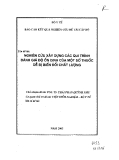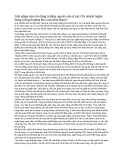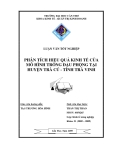JOURNAL OF FOREST SCIENCE, 54, 2008 (6): 255–261
Can 13C stable isotope record of Norway spruce tree rings display the effect of environmental conditions?
L. Píšová1, M. Svoboda1, J. Šantrůček2, H. Šantrůčková2
1Faculty of Forestry and Wood Sciences, Czech University of Life Sciences Prague, Prague, Czech Republic 2Faculty of Science, University of South Bohemia in České Budějovice, České Budějovice, Czech Republic
ABSTRACT: The Bohemian Forest Mts. (Šumava) were exposed to heavy atmospheric pollution in the last century. A possible negative effect of atmospheric pollution on tree physiology has been studied using the isotopic composition, Δ13C, of tree rings. The wood is depleted of 13C relative to the air due to isotopic discrimination against 13C and preferred uptake of 12C during photosynthesis. The ratio 13C/12C (Δ13C) reflects the relative magnitudes of net assimilation and stomatal conductance that relate to demand and supply of CO2. Carbon-13 data are thus a useful index for assessing intrinsic water use efficiency (mark period of drought or root system damages) and also could indicate assimilation organ injure (needle damage caused due to acid rain etc.). A decrease in Δ13C implies a negative effect of environmental condi- tions on tree physiology. Presumably, changes in soil pH and aluminium content as an indirect effect of atmospheric pollution could have an impact on tree physiology. Our results showed that the isotopic signal varied around the aver- age, but the Δ13C signal was decreasing from the 1950s to 1980s and then increasing again starting in the 1990s. This trend is in accordance with the monitored atmospheric pollution and soil solution pH changes.
Keywords: Δ13C; air pollution; tree physiology; Bohemian Forest Mts.; soil pH; aluminium; soil acidification
In the past, the nutrient balance and development of trees in many areas of Central Europe were affected by acidification that occurred in this region (Matzner, Murach 1995). The acidification of soils caused the loss of base cations and an increase in the content of acid cations in the cation exchange complex of the soils (Séguin et al. 2004). Global climate changes connected with increasing temperature and decreasing precipita- tion can also constitute another interference of spruces which are rooting in the upper soil layers (Puhe 2003). However, there is still an uncertainty to what degree and how long the trees have been affected.
A parameter is needed to assess the effect of envi- ronmental conditions on spruce tree development in the past and to improve a decision-making of for-
est management in the future. The 13C stable isotope record in tree rings has been shown to provide a valuable insight into the history of environmental effects (moisture, temperature, atmospheric and soil pollution) on the tree physiological activity (West et al. 2006). The carbon stable isotope ratio (13C/12C) of plant biomass is a widely used indicator because of the integrative response of the isotopic ratio to multiple eco-physiological constraints during the time of biomass development (Dawson et al. 2002). Carbon dioxide in the atmosphere is composed of molecules with a light atom of C (12C, 98.89%) and molecules with a heavy atom of C (13C, 1.11%). There is an isotope discrimination against carbon dioxide with 13C during carbon dioxide fixation
Supported by the Ministry of Education, Youth and Sports of the Czech Republic, Project No. MSM 600 766 5801, the Grant Agency of the Czech Republic, Project No. 206/07/1200, the Grant Agency of the Czech University of Life Sciences, Project No. 20074003, and the Grant Agency of Faculty of Forestry and Wood Sciences, Project No. 23/2007.
J. FOR. SCI., 54, 2008 (6): 255–261
255
)
19.0 18.5 Fig. 1. Long-term trends of Δ13C average values of tree rings from research conducted by Šantrůčková et al. (2007) 18.0 17.5 17.0 16.5 ‰ ‰ C ( 3 C 1 3 (cid:507) 1 ∆ 16.0 15.5 15.0 1860 1880 1900 1920 1940 1960 1980 2000 2020
in photosynthesis, resulting in depletion of 13C in plant biomass. The rate of discrimination is affected by environmental conditions such as temperature, water availability, atmospheric pollution, nutrient availability etc., which affect stomatal conduct- ance and photosynthesis rate (Farquhar et al. 1982; Martin, Sutherland 1990; McCarroll, Loader 2004; Helle, Schleser 2004). For trees, the effects of environmental changes on the tree physiological activity in the past can be recorded from the fluctuation of the carbon stable isotope ratio in tree rings and assigned to the exact year or time period (Guyette, Cutter 1994).
detected in the Bavarian Forest (Wilson, Elling 2004) and the northern part of the Czech Republic (Kroupová 2002). In the Bohemian Forest Mts., the negative effects of atmospheric depositions and soil acidification on isotopic composition and chemistry of tree rings and, therefore, on the tree physiologi- cal activity have been indicated (Šantrůčková et al. 2007; Fig. 1). However, the preliminary study by Šantrůčková et al. (2007) was performed using the 13C stable isotope record from three trees only. The main objective of our study was to enlarge the data set and to validate the finding that the tree physiolog- ical activity was negatively affected by atmospheric depositions and soil acidification in this area.
Norway spruce (Picea abies [L.] Karst.) is a domi- nant tree species in commercial forests in the Czech Republic. The forests have been affected very much by increasing sulphur and nitrogen deposition and subsequent soil acidification over more than one century (Psenner, Catalan 1994). Spruce forests in acid sensitive areas, usually those with the crys- talline bedrock and naturally low base saturation of soils, have remained exposed to the effect of soil acidification after the decline of atmospheric depo- sition, which can result in the growth depression of trees. Growth depression of Norway spruce was
The research was carried out in a forest stand located in the catchment of the Čertovo Lake in the Bohemian Forest Protected Landscape Area. This area was ex- posed to heavy atmospheric pollution in the last century (Veselý 1994; Fig. 2), which was followed by significant soil acidification (Kopáček et al. 2001, 2002a). The MAGIC7 model suggested that soil pH did not vary sig- nificantly until the late 1950s, then it began to decrease at the same time with increasing Al concentration. Acid deposition and also Al content in the soil solution de- creased in the 1980s (Majer et al. 2003; Fig. 3).
Year
)
2
2
m m / l / o l o m m m m
(
160 NH4 NH4 NO3 NO3 SO4 SO4 140 120 100 80 60 40 20
0 1850 1900 2000 2050 1950 Fig. 2. Long-term trends of atmospheric deposition. Data were derived from Kopáček et al. (2001) Year
J. FOR. SCI., 54, 2008 (6): 255–261
256
H p
) l / l o m µ ( l
A
Al pH 4.7 4.65 Fig. 3. Long-term trends of pH and Al concentration of soil solution (adapted according to Majer et al. 2003) 4.6 4.55 4.5 4.45 4.4 4.35 4.3 90 80 70 60 50 40 30 20 10 0 1860 1880 1900 1920 1940 1960 1980 2000
Year
MATERIAL AND METHODS
and charcoal and potash production from the Middle Ages to the late 19th century (Veselý 1994).
Site description
Sampling and analyses
The area has a humid climate with wet cold winters and wet mild summers. A trend of increasing temper- atures has been detected in this area since the 1960s (Kettle et al. 2003). The mean annual temperature is 3.4°C and the mean annual precipitation is 1,228 mm. The bedrock of the catchment is composed of mica- schist (muscovitic gneiss), quartzite, and small amounts of pegmatite (Veselý 1994). Soil types mostly belong to Cambisols, Podzols and Lithosols on steep slopes in the watersheds. Some information about soil properties is in Table 1; for a more detailed description see Kopáček et al. (2002b).
We randomly selected three Norway spruce trees older than 150 years in the Čertovo Lake catchment in the area of Jezerní hora Mt. The selected trees were without apparent defects such as putrefaction or crown damage. Trees were sampled from near breast height (cores from two opposite exposures). Rings were sectioned by decades and analyzed for the iso- topic composition. Only those rings were evaluated that were formed after the juvenile effect (Leavitt, Long 1985; Liu et al. 2004) ceased (40 years). Samples were dried and homogenized in a ball mill (MM200 Retsch, Haan, Germany). Isotopic analyses were carried on an elemental analyzer (EA1110, Ther- moQuest Italia s.p.a.) linked to DeltaXLplus (Ther- moFinnigan, Bremen, Germany). The ratio of 13C to 12C was expressed in delta (δ) notation with reference
The Čertovo Lake catchment is covered with 90 to 150 years-old Norway spruce (Picea abies [L.] Karst.) forest of at least secondary origin, with scarce Euro- pean beech (Fagus sylvatica L.). The land use history of the catchment suggests important timber harvesting
Table 1. Average composition of individual soil horizons in the Čertovo Lake watershed adapted according to Kopáček et al. (2002b)
Soil properties CO CA CAe CE CB CC 5 10 24 17 20 22 4 24 159 81 80 184 3.6 3.6 4.3 4.1 4.2 4.7 Depth Soil (kg/m2) pHH2O C (mol/kg) 41 26 12 3.3 3.6 3.1 N (mmol/kg) 1,603 1,028 450 143 151 54 P (mmol/kg) 34 34 31 13 28 16 Ca (mmol/kg) 50 30 33 32 22 18 Mg (mmol/kg) 28 56 146 67 108 172 K (mmol/kg) 61 242 386 542 474 477 Al (mmol/kg) 0.3 1.5 2.7 2.7 2.6 2.6 Fe (mmol/kg) 102 241 596 206 595 637 Mn (mmol/kg) 3.2 3.6 4.0 5.5 4.4 5.1
J. FOR. SCI., 54, 2008 (6): 255–261
257
to standard material (δ13C = Rsample/Rstandard – 1), which was fossil belemnite in this case (Vienna-PDB, VPDB, McCarroll, Loader 2004).
There is a discrimination against 13C in C3 plants by the carboxylating enzyme Rubisco (~ 27‰) and during diffusion through the stomata (~ 4.4‰), which is linked to photosynthesis through the ratio of inter- cellular to atmospheric CO2 concentrations (ci/ca). Discrimination in C3 plant can be expressed as:
average Δ13C was shifted approximately by one ‰ (17.5‰, 17.2‰ and 16.2‰, respectively). The Δ13C increased from the late 1850s till the end of the 19th century. Then it slowly decreased until the 1980s and the decrease becomes faster from 1950s till 1980s. The past decrease corresponds to the period of heavy atmospheric and soil pollution of the area (Figs. 2 and 3). Δ13C has been increasing since the early 1990s, indicating biological recovery.
Δ (‰) = a + (b–a)(ci/ca)
DISCUSSION
The highest Δ13C values show plants at optimum environmental conditions (optimum growth and mostly largest isotope discrimination). The sensi- tivity of Δ13C is weak around the optimum of plant growth. The sensitivity of Δ13C to environmental changes increases progressively below and above the optimum ( Martin, Sutherland 1990; Helle, Schleser 2004).
In this study, isotope ratios were expressed in terms of discrimination against 13C in the atmos- phere (∆13C = (δ 13CATM – δ 13C PLANT)/ (1 + δ 13C PLANT) ≈ (δ 13CATM – δ 13C PLANT); Farquhar et al. 1989) to remove the effect of atmospheric δ 13C de- cline. The atmospheric δ 13C signal was corrected us- ing estimates based on the Antarctic ice core record (McCarroll, Loader 2004).
where: a – discrimination against 13CO2 during diffusion through the stomata, – net discrimination due to carboxylation, b ci, ca – intercellular and ambient CO2 concentrations (Far- quhar et al. 1982; McCarroll, Loader 2004).
RESULTS
Variation in the 13C isotopic signal at the end of the 19th century and at the beginning of the 20th century might be a reaction to the closure of pasturing and timber harvesting (Veselý 1994) in conjunction with the long-term effect of spruce monocultures, with their natural acidifying influences (Herbauts, De Buyl 1981). The rapid decrease in Δ13C in tree I began in 1920, for the other two trees (tree II and III) in 1940. The rapid decrease between the 1950s and 1980s is in accordance with the period of heavy atmospheric pollution which accelerated soil acidifi- cation followed by decreased base cation availability and increased aluminium toxicity (Kopáček et al. 2002a; Séguin et al. 2004). Šantrůčková et al. (2004) noted that the greatest changes in soil chem- istry and biochemistry took place in the litter and humus horizons where spruces had most of their roots (Puhe 2003; Ostonen et al. 2005). Higher aluminium concentrations induce a shift of roots into the upper soil layers, because aluminium of even less than micromolar concentrations inhibits root elongation (Ma 2005). The results indicate tree abionosis, i.e. the harmful effect of soil acidification on the trees.
The pattern of changes in an isotopic signal dis- played the same trend for all trees (Fig. 4), though
Also the acid rain which fell in the 1970s and 1980s could have impacted the isotopic signal. Sulphur
)
Tree I Tree II Tree III
‰ ‰ C ( 3 C 1 3 (cid:507) 1 ∆
18.5 18.0 17.5 17.0 16.5 16.0 15.5 15.0 14.5 14.0 1860 1880 1900 1920 1940 1960 1980 2000 2020
Year Fig. 4. Long-term trends of Δ13C signal in 10-year tree samples from Jezerní Mt.
J. FOR. SCI., 54, 2008 (6): 255–261
258
emissions may have caused especially foliage dam- age (Sutinen et al. 1998), thereby affecting carbon fixation. The relatively quick recovery can be due to the assimilatory apparatus regeneration. An increase in temperature of about 1.5°C (Kettle et al. 2003) has not probably yet had any impact on the biological recovery that started in the 1980s.
As compared to needle analyses, the analysis of Δ13C of tree rings provides a long term record of the effect of environmental conditions. Needle analyses might provide information only about the effect of environmental conditions in the cur- rent year (Solberg, Torseth 1997; Sutinen et al. 1998). This would also be true of analyses of soil changes induced by air pollution and interpreting these changes in connection with tree physiology (Matzner, Murach 1995; Solberg et al. 2004).
CONCLUSIONS
The differences in Δ13C between the trees may reflect their different genetic dispositions or social and ecological positions. The same trend in the time change of Δ13C, however, shows that all three trees were exposed to the same effect of environmental conditions; this is more important than the abso- lute values. The isotopic signal changes appreciated relative to the average of the whole trees. The pre- sented results correspond to the analyses previously performed on other four trees (Šantrůčková et al. 2007) from a nearby area.
Stable isotope dendroecology is a relatively young field with advances in sample preparation technique, clear physiological background and understanding how environmental factors influence the isotope fractionation. Stable isotope methods have recently emerged as one of the most powerful tools for under- standing the relationship between plants and their environment. The applied method seems to be good and is worth testing in other regions. Our results confirm the negative effect of atmospheric and soil pollution on tree physiology.
Special thanks to Jiří Květoň and Martina Vašková for their work with the mass-spec, and Keith Edwards for language corrections.
Acknowledgement
R e f e r e n c e s
BORELLA S., LEUENBERGER M., SAURER M., SIEGWOLF R., 1998. Reducing uncertainties in delta C-13 analysis of tree rings: Pooling, milling, and cellulose extraction. Jour- nal of Geophysical Research – Atmospheres, 103 (D16): 19519–19526.
DAWSON T.E., MAMBELLI S., PLAMBOECK A.H., TEM- PLER P.H., TU K.P., 2002. Stable isotopes in plant ecology. Annual Review of Ecology Systematics, 33: 507–59.
ELHANI S., GUEHL J.M., NYS C., PICARD J.F., DUPOUEY J.L., 2005. Impact of fertilization on tree-ring δ15N and δ13C in beech stands: a retrospective analysis. Tree Physiology, 25: 1437–1446.
FARQUHAR G.D., O,LEARY M.H., BERRY J.A., 1982. On the relationship between carbon isotope discrimination and intercellular carbon dioxide concentration in leaves. Australian Journal of Plant Physiology, 9: 121–137.
There is no consensus in terms of what type of material to use for isotopic analyses. Schweingru- ber (1996) reported that the most reliable values of Δ13C were given by measuring isotopes in cellulose because only the cell-wall component contains non- mobile organic elements. But Loader et al. (2003) and Elhani et al. (2005) suggested that the climate signal in the Δ13C values of whole wood may be stronger than the one in cellulose or lignin. Harlow et al. (2006) stated that holocellulose extraction was unnecessary for most analyses of tree-ring Δ13C. Borella et al. (1998) argued that wood is as good a climate proxy as cellulose. It is also recommended to use only late wood (McCarroll, Loader 2004). However, the tree growth is extremely slow in many areas and separation of latewood has proved to be almost impossible when the rings are really narrow. Hill et al. (1995) noted that the δ13C value of early wood correlates best with the late wood formed in the previous year because early wood cells are manufactured partly using stored photosynthates and smaller cells of latewood formed during the summer (Switsur et al. 1995). The whole ring can only give an integrated carbon isotope value which is frequently taken as an annual record of environmen- tal conditions. Often, it may merely be information about a very specific part of the year. In many cases, wood is laid down during a short period of the year (frequently in Central European trees) and the iso- topic signal primarily corresponds to the conditions of this time interval (Schlesser et al. 1999). Whole rings (late wood and early wood) were used for iso- tope analyses in this study. 10-year averages are used for Δ13C interpretation, thus the Δ13C interference of early wood performed in the previous year is extrin- sic. Cellulose extraction was not made.
FARQUHAR G.D., EHLERINGER J.R., HUBICK K.T., 1989. Carbon isotope discrimination and photosynthesis. Annual Reviews of Plant Physiology and Plant Molecular Biology, 40: 503–537. GUYETTE R.P., CUTTER B.E., 1994. Barium and manganese
J. FOR. SCI., 54, 2008 (6): 255–261
259
trends in tree-rings as monitors of sulfur deposition. Water, Air, and Soil Pollution, 73: 213–223. acidification: Part I – the Bohemian Forest. Hydrology and Earth System Sciences, 7: 494–509.
HARLOW B.A., MARSHALL J.D., ROBINSON A.P., 2006. A multi-species comparison of delta C-13 from whole wood, extractive-free wood and holocellulose. Tree Physiology, 26: 767–774. MARTIN B., SUTHERLAND E.K., 1990. Air pollution in the past recorded in with and stable carbon isotope composi- tion of annual growth rings of Douglas-fir. Plant, Cell and Environment, 13: 839–844.
MATZNER E., MURACH D., 1995. Soil changes induced by air pollutant deposition and their implication for forests in Central Europe. Water, Air and Soil Pollution, 85: 63–76. HELLE G., SCHLESSER G.H., 2004. Interpreting climate pro- xies from tree-rings. In: FISCHER H., FLOESER G., KUMKE T., LOHMANN G., MILLER H., NEGENDANK J.F.W., VON STORCH H. (eds), The KIHZ Project: Towards a Synthesis of Holocene Proxy Data and Climate Models: 129–148. McCARROLL D., LOADER N.J., 2004. Stable isotopes in tree rings. Quaternary Science Reviews, 23: 771–801.
HERBAUTS J., DE BUYL E., 1981. The relation between spruce monoculture and incipient podzolisation in ochre- ous brown earths of the Belgian Ardennes. Plant and Soil, 59: 33–49.
OSTONEN I., LOHMUS K., PAJUSTE K., 2005. Fine root biomass, production and its proportion of NPP in a fertile middle-aged Norway spruce forest: Comparison of soil core and ingrowth core methods. Forest Ecology and Manage- ment, 212: 264–277.
HILL S.A., WATERHOUSE J.S., FIELD E.M., SWITSUR V.R., APREES T., 1995. Rapid recycling of triose phosphate in oak stem tissue. Plant, Cell and Environment, 18: 931–936. KETTLE H., KOPÁČEK J., HEJZLAR J., 2003. Modelling air temperature at Čertovo lake back to 1781. Silva Gabreta, 9: 15–32.
PSENNER R., CATALAN J., 1994. Chemical composition of lakes in crystalline basins: A combination of atmospheric deposition, geological background, biological activity, and human action. In: MARGALEF R. (ed.), Limnology Now: A Paradigm of Planetary Problems. New York, Elsevier: 255–314.
KOPÁČEK J., VESELÝ J., STUCHLÍK E., 2001. Sulphur and ni- trogen fluxes and budgets in the Bohemian Forest and Tatra Mountains during the Industrial Revolution (1850–2000). Hydrology and Earth System Sciences, 5: 391–406. PUHE J., 2003. Growth and development of the root system of Norway spruce (Picea abies) in forest stands – a review. Forest Ecology and Management, 175: 253–273.
KOPÁČEK J., STUCHLÍK E., VESELÝ J., SCHAUMBURG J., ANDERSON I.C., FOTT J., HEJZLAR J., VRBA J., 2002a. Hysteresis in reversal of Central European mountain lakes from atmospheric acidification. Water, Air, and Soil Pollu- tion, 2: 91–114. SÉGUIN V., GAGNON CH., COURCHESNE F., 2004. Changes in water extractable metals, pH and organic carbon concentrations at the soil-root interface of forested soils. Plant and Soil, 260: 1–17.
SCHLESSER G.H., HELLE G., LÜCKE A., VOS H., 1999. Isotopes signals as climate proxies: the role of transfer functions in the study of terrestrial archives. Quaternary Science Reviews, 18: 927–943. KOPÁČEK J., KAŇA J., ŠANTRŮČKOVÁ H., PORCAL P., HEJZLAR J., PICEK T., ŠIMEK M., VESELÝ J., 2002b. Physical, chemical, and biochemical characteristics of soils in watersheds of the Bohemian Forest lakes: II Čertovo and Černé lakes. Silva Gabreta, 8: 63–93.
KROUPOVÁ M., 2002. Dendroecological study of spruce growth in regions under long-term air pollution load. Journal of Forest Science, 48: 536–548. SCHWEINGRUBER F.H., 1996. Tree Rings and Environment. Dendroecology. Birmensdorf, Swiss Federal Institute for Forest, Snow and Landscape Research. Berne, Stuttgart, Vienna, Haupt: 609.
LEAVITT S.W., LONG A., 1985. Stable-carbon isotopic composition of maple sap and foliage. Plant Physiology, 78: 427–429. SOLBERG S., TORSETH K., 1997. Crown condition of Nor- way spruce in relation to sulphur and nitrogen deposition and soil properties in southeast Norway. Environmental Pollution, 96: 19–27.
LIU Y., MA L., LEAVITT S.W., CAI Q., LIU W., 2004. A preliminary seasonal precipitation reconstruction from tree-ring stable carbon isotopes at Mt. Helan, China since AD 1804. Global Planet Change, 41: 229–239.
SOLBERG S., ANDREASSEN K., CLARKE N., TORSETH K., TVEITO O.E., STRAND G.H., TOMTER S., 2004. The possible influence of nitrogen and acid deposition on for- est growth in Norway. Forest Ecology and Management, 192: 241–249.
LOADER N.J., ROBERTSON I., McCARROLL D., 2003. Com- parison of stable isotope ratios in the whole wood, cellulose and lignin of oak tree-rings. Palaeography, Palaeoclimatol- ogy, Palaeoecology, 196: 395–407.
MA J.V., 2005. Plant root responses to three abundant soil minerals: silicon, aluminium and iron. Critical Reviews in Plant Sciences, 24: 267–281. SUTINEN S., LUMME I., MÄENPÄÄ M., ARKHIPOV V., 1998. Light microscopic structure of needles of Scots pine (Pinus sylvestris L.) in relation to air pollution and needle element concentrations in S.E. Finland and the Karelian Isthmus, N.W. Russia. Trees, 12: 281–288.
MAJER V., COSBY B.J., KOPÁČEK J., VESELÝ J., 2003. Model- ling reversibility of Central European mountain lakes from SWITSUR V.R., WATERHOUSE J.S., FIELD E.M., CARTER A.H.C., LOADER N.J., 1995. Stable isotopes studies in tree
J. FOR. SCI., 54, 2008 (6): 255–261
260
rings from oak-techniques and some preliminary results. Paläoklimaforschung, 15: 129–140. WEST J.B., BOWEN G.J., CERLING T.E., EHLERINGER J.R., 2006. Stable isotopes as one of nature,s ecological recorders. Trends in Ecology and Evolution, 21: 408–414.
ŠANTRŮČKOVÁ H., VRBA J., PICEK T., KOPÁČEK J., 2004. Soil biochemical activity and P transformations and losses from acidified forest soils. Soil Biology & Biochemistry, 36: 1569–1576. WILSON R.J.S., ELLING W., 2004. Temporal instability in tree growth/climate response in the Lower Bavarian For- est region: Implications for dendroclimatic reconstruction. Trees, 18: 19–28.
Received for publication November 7, 2007 ŠANTRŮČKOVÁ H., ŠANTRŮČEK J., ŠETLÍK J., SVOBODA M., KOPÁČEK J., 2007. Carbon isotopes in tree ring of Norway spruce exposed to atmospheric pollution. Environ- mental Science & Technology, 41: 5778–5782. Accepted after corrections March 21, 2008
VESELÝ J., 1994. Investigation of the nature of the Šumava lakes: a review. Časopis Národního Muzea, Řada přírodovědná, 163: 103–120.
Mohou stabilní izotopy uhlíku 13C v letokruzích smrku ztepilého indikovat změny v podmínkách prostředí?
ABSTRAKT: V minulém století byly lesy v oblasti Šumavy vystaveny silnému znečištění ovzduší. Možný negativní efekt znečištění ovzduší na fyziologii smrku ztepilého byl studován pomocí stabilních izotopů Δ13C v letokruzích stromů. Rostliny během fotosyntetické fixace uhlíku preferují 12C před 13C, a proto dřevo stromů obsahuje méně 13C v porovnání se vzduchem. Poměr lehkého a těžkého izotopu uhlíku v rostlinách je závislý na rychlosti fotosyntézy a otevřenosti průduchů. V izotopovém signálu jsou proto zachycena období sucha, případně poškození kořenového systému stejně jako asimilačního aparátu (např. poškození jehlic způsobené kyselými dešti). Pokles v Δ13C v rostlině indikuje negativní efekt podmínek prostředí na fyziologii stromu. Podle předpokladu, že změny pH půdy a obsahu hliníku jako nepřímého efektu znečištění ovzduší mohou ovlivňovat fyziologii smrku, by se tyto změny mohly stu- dovat pomocí skladby izotopů v letokruzích smrku. Izotopový signál v letokruzích stromů se během analyzovaného období pohyboval kolem průměrné hodnoty, zatímco signál Δ13C klesal mezi roky 1950 až 1980 a opět stoupal po roce 1990. Tento trend je v souladu se zaznamenanými změnami v pH půdy a v atmosférické depozici.
Klíčová slova: Δ13C; znečištění ovzduší; fyziologie stromu; Šumava; pH půdy; hliník; acidifikace půdy
Ing. Miroslav Svoboda, Česká zemědělská univerzita v Praze, Fakulta lesnická a dřevařská, 165 21 Praha 6-Suchdol, Česká republika tel.: + 420 224 383 405, fax: + 420 234 381 860, e-mail: svobodam@fld.czu.cz
Corresponding author:
J. FOR. SCI., 54, 2008 (6): 255–261




































